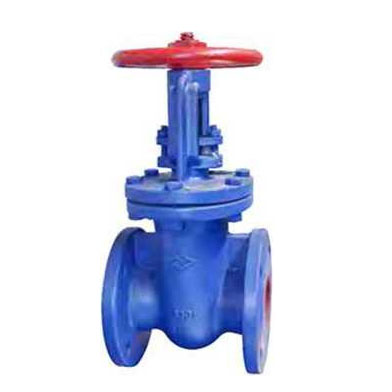A bobtail consists of the drivetrain and the propane system, including the barrel (container) and the components that make up the delivery portion. Some typical components included in the delivery portion are:
Here, I discuss the operation and safety of the internal valve. Internal valves come in several types and configurations. Threaded internal valves have a large male thread that allows them to be installed into a female thread inside the container. Flanged internal valves use a single or double flange that requires specially designed bolts and nuts for installation. Metering Ball Valve

Flanged internal valve in the closed position. (Image courtesy of Cavagna Group)
The internal valve acts as the primary safety shut-off valve for the container. It is designed with a closing mechanism located inside the container and specific shear points to allow the closing portion of the valve to remain inside the container if the valve is severed.
When the internal valve is in the closed position, the closing spring of the valve and the pressure of the propane inside the container pushes against the closing mechanism, ensuring a tight seal.
The internal valve is opened when the lever arm is rotated, which operates a cam inside the valve. This cam pushes against the valve stem, creating a partial opening, or bleeding, which allows some propane to flow.
As propane continues to bleed through the valve, the downstream pressure begins to increase. Once the downstream pressure equalizes with container pressure, the internal valve’s main seat opens, allowing full flow. The main seat also acts as an excess flow device and will shut closed in the event the flow of propane exceeds the allowable flow rate.
The excess flow is another safety device built into the internal valve. It protects against unintentional release in the event of damage downstream of the valve, and protects the downstream system from a higher flow rate than the designated set point.
As described above, if the flow through the valve exceeds the designated set point, the main seat will close. However, the valve stem remains in the open position, restricting flow through the equalizing area. The main seat will remain closed until the pressure equalizes, which then allows the main seat to reopen. Opening valves downstream of the internal valve can cause a sudden pressure drop, which can cause the excess flow device to close again.
The internal valve is closed when the lever arm is rotated back to its original position, which closes the stem and the main seat, instantly stopping the flow of propane.
It is common for bobtail internal valves to be fitted with pneumatic actuators. These actuators allow the operator to remotely open and close the internal valve.
Internal valves can also be installed with thermal latches. These latches will hold the level arm of the internal valve open during normal operation and will automatically release the lever arm, enabling the internal valve to close in the event that it is exposed to a fire or temperatures exceeding 212 degrees F. These latches can also be equipped with a cable that allows the operator to release the lever arm and close the valve from a remote distance.
The Propane Education & Research Council is an excellent source for information on filling customer containers with a bobtail, bobtail components and the operation of internal valves. Check out these educational materials at propane.com.
Randy Warner is product safety manager for Cavagna North America. He can be reached at randywarner@us.cavagnagroup.com.
NOTE: The opinions and viewpoints expressed herein are solely the author’s and should in no way be interpreted as those of LP Gas magazine or any of its staff members.
If you enjoyed this article, subscribe to LP Gas to receive more articles just like it.

Slab Gate Valve © 2023 North Coast Media LLC, All Rights Reserved.